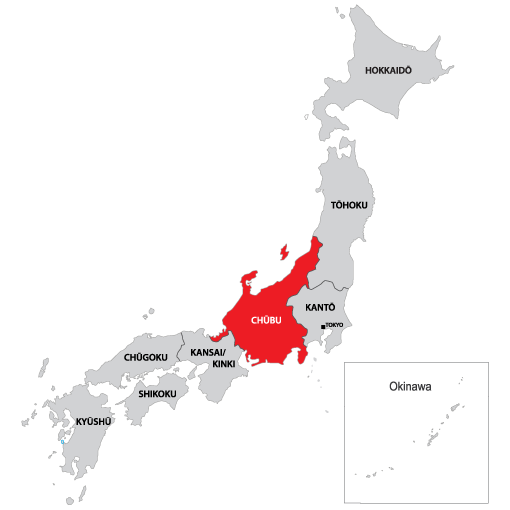
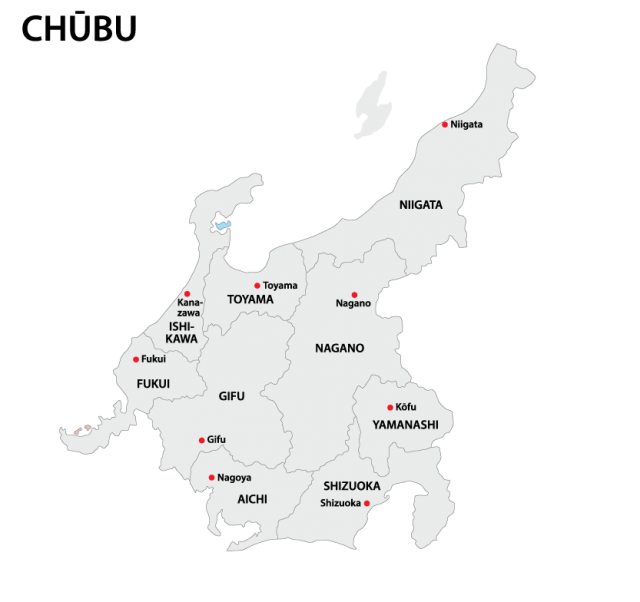
The Chubu region in Central Japan features some of Japan’s most mountainous territory, containing not just Mount Fuji, but also the Southern, Central, and the Northern Japanese Alps.
Passing through the area by bullet train alone leaves most travelers unaware of the natural beauty and cultural heritage that lies in Japan’s central belt.
Yamanashi Prefecture
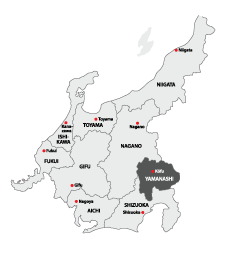 Mt Fuji is sufficiently large that it straddles both Yamanashi Prefecture in the North, and Shizuoka Prefecture in the south. In the Northern area of Fujisan, the Fuji Five Lakes or Fuji-go-ko area offers water sports and varying views of Mount Fuji. The five lakes are Yamanakako, Kawaguchiko, Saiko, Shojiko, and Motosuko. Yamanakako lies to the southeast of Kawaguchiko and is the largest of the five lakes and among the most developed. There are ryokan along the lake but few that have good views of Mount Fuji.
Mt Fuji is sufficiently large that it straddles both Yamanashi Prefecture in the North, and Shizuoka Prefecture in the south. In the Northern area of Fujisan, the Fuji Five Lakes or Fuji-go-ko area offers water sports and varying views of Mount Fuji. The five lakes are Yamanakako, Kawaguchiko, Saiko, Shojiko, and Motosuko. Yamanakako lies to the southeast of Kawaguchiko and is the largest of the five lakes and among the most developed. There are ryokan along the lake but few that have good views of Mount Fuji.
Between Yamanakako and Kawaguchiko likes the Fujiyoshida area. For a more traditional view of Japan, you may wish to visit Oshino Hakkai, a village of preserved thatch-roofed buildings set around eight ponds. It is popular with tourists given its proximity to Tokyo. The adjoining open-air museum collecting architecture from the area provides insights into life at the foot of Fujisan. For those seeking thrills, the FujiQ amusement park is nearby. In the Fujiyoshida area, the Chureito pagoda of Arakura Sengen Shrine is a popular photography spot for shots of Fujisan from within the cherry blossoms. The new Fujisan World Heritage Center is located a short drive from the FujiQ amusement park at the gateway to the Subaru Line Toll Road. The Fujisan museum provides context to the worship of Fujisan in Shinto as a sacred mountain. The traditional start of the Yoshida climbing route to ascent Fujisan is the Fujiyoshida Sengen Shrine, dedicated to the kami associated with Fujisan. Most climbers now eschew tradition, and, with time at a premium, begin their climb from the Subaru 4th station.
Kawaguchiko is a resort area lying on the Northern side of Mount Fuji and is famous for its views of the mountain when weather conditions permit. The mirror reflection of Fujisan on the surface of the lake is one of the iconic images of the area. On the northern side of Lake Kawaguchi, the Kubota Itchiku Museum is a quirky museum of the personal collection of textile artist Kubota Itchiku, but the stars of the museum are examples of his kimono and textiles. Kawaguchiko is also the most accessible of the Fuji Five Lakes and is a jumping-off point for the Fuji Subaru Line and the Subaru 5th Station, one of the more popular starting points for hikers seeking to ascend Mount Fuji via the Yoshida trail. While there is little to recommend the 5th station for non-climbers but souvenir shops and restaurants, on days when low-level clouds cover the area, it may be possible to look down upon a ‘sea of clouds’ sitting below the 5th station.
Saiko lies to the West of Kawaguchiko and is less developed. There are some limited hiking trails around the lake and in the nearby Aokigahara forest. The Iyashinosato open-air museum sits on a site where a mountain village was wiped out by a landslide. The traditional-style buildings seek to recapture the town atmosphere and are home to craftspeople and small shops. Several caves also lie around the lake. The smallest of the lakes, Shojiko, lies west of Saiko. Hiking and watersports are popular around the lake in the summer months. Finally, the last of the five lakes is Lake Motosuko – the least developed and most difficult to access unless traveling the area by rental car. Flower lovers may wish to visit from late April to mid-May when the nearby Shibazakura festival takes place and the fields bloom with moss phlox.
Fujisan is not the only attraction of Yamanashi prefecture. You’ll also find Japan’s oldest ryokan – also the world’s longest continuously operating hotel. History comes at a premium, but hospitality that has been honed for 52 generations offers something different from the usual overnight stay. For those that enjoy fruit or the fruit of the vine, Yamanashi’s moderate climate makes it the ideal place for fruit cultivation, as well as wine production, particularly in the Katsunuma area. The western part of the prefecture is bordered by the Southern Alps, and Kitadake, is Japan’s second tallest mountain. The Southern Alps biosphere reserve is a United Nations biosphere reserve, characterized by alpine plants and flowers, and fauna native to Japan. The area bears traces of Jomon history and development and local crafts are preserved in the area. To the North, the prefecture is bordered by the Southern Yatsugatake Volcanic group – mountains that are now dormant volcanoes.



Shizuoka Prefecture
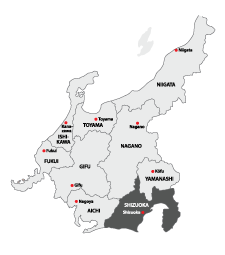 The southern face and area around Fujisan fall in Shizuoka prefecture and there is some rivalry between Yamanashi and Shizuoka as to which prefecture provides a better means to experience the area. Shizuoka may not have the same range of attractions as are found on the Northern side of Japan’s largest mountain, but it offers another popular ascent to the mountain. Traditionally climbers began at Fujisan Hongu Sengen Taisha in Fujinomiya, South West of Fujisan. The shrine is one of the most important in the area, built over 1000 years ago to protect the people of the area from volcanic eruptions. The shrine is also the head shrine for Sengen and Asama shrines throughout Japan. In modern times, the ascent begins now from Fujinomiya 5th Station and is popular as the shortest of the ascents. Fujinomiya is also home to Shiraito Falls, known for its beauty. The snow-fed falls stretch 150m wide, giving them the appearance of silk threads, from which they take their name. Shizuoka also has its own Fujisan World Heritage Center, also found in Fujinomiya.
The southern face and area around Fujisan fall in Shizuoka prefecture and there is some rivalry between Yamanashi and Shizuoka as to which prefecture provides a better means to experience the area. Shizuoka may not have the same range of attractions as are found on the Northern side of Japan’s largest mountain, but it offers another popular ascent to the mountain. Traditionally climbers began at Fujisan Hongu Sengen Taisha in Fujinomiya, South West of Fujisan. The shrine is one of the most important in the area, built over 1000 years ago to protect the people of the area from volcanic eruptions. The shrine is also the head shrine for Sengen and Asama shrines throughout Japan. In modern times, the ascent begins now from Fujinomiya 5th Station and is popular as the shortest of the ascents. Fujinomiya is also home to Shiraito Falls, known for its beauty. The snow-fed falls stretch 150m wide, giving them the appearance of silk threads, from which they take their name. Shizuoka also has its own Fujisan World Heritage Center, also found in Fujinomiya.
The Izu Peninsula sits south of Fujisan in Eastern Shizuoka Prefecture. The Izu Peninsula is known for its hot springs and their role in the history of modern Japan. The seaside towns of Atami, Ito, and Shimoda on the Eastern side of the peninsula have become popular getaways for residents of Tokyo due to their beaches and onsen. Atami is blighted by the 1980’s boom period resort hotels, but further inland, particularly in the areas of the Izu Peninsula UNESCO Geopark, the area offers sea kayaking, snorkeling, clifftop hiking, cycling, and dramatic landscapes, particularly along the Jogasaki and Irozaki coasts. Kawazu is famous for its cherry blossoms and the Kawazu Seven Waterfalls or Nanaderu. Shimoda was where Commodore Perry and his black ships landed and forced the opening of Japan to the world. Inland in the north-central area of the peninsula, Shuzenji is a more elevated onsen town with a rich history. This onsen town was allegedly founded 1200 years ago by Kobo Daishi, also known for his monastery complex at Koyasan and the 88 Temple Pilgrimage route in Shikoku. The area was long a refuge and remains so to this.
Shizuoka city is found in central Shizuoka prefecture. Near the city, the Kunozan Toshogu Shrine enshrines historical figures, Tokugawa Ieyasu, Toyotomi Hideyoshi, and Oda Nobunaga in a mountainside setting accessed by hundreds of steps. Tokugawa Ieyasu spent the last decade of his life at Sumpu Castle in Shizuoka city and the ruins of the castle still stand in the city. East of the Shrine lies Miho no Matsubara Beach, a beach lined with pine trees that offers lovely views over Suruga Bay to Mount Fuji.
In the West, Shizuoka’s famed tea is grown, and Kakegawa, Kanaya, Fukuroi, and Gyokuro-no-Sato are all excellent areas to learn more about the cultivation of green tea in Japan. The tea plantations surrounding Kakegawa are particularly picturesque as they line the rolling hills. Hamamatsu is known for its production of musical instruments, and also has a role in history as one of the post towns on the old Tokaido route that followed the sea from Tokyo to Kyoto. The old Waki Honjin of the late Edo period in Hamamatsu City is the last that remains along the Tokaido. The older checkpoint of the Hime Highway illustrates how traffic was controlled in the country. Tokugawa Ieyasu lived some years in the now restored Hamamatsu Castle. The good and the great of his circle also spent time there, leading the castle to be called the ‘Castle of Success’. The nearby Nakatajima sand dunes are popular with surfers and are also home to Loggerhead turtles who come here in summer to lay eggs. And the hatchlings emerge from August to October. Lake Hamana, a seaside saltwater lake offers water sports and some modern onsen ryokan. It’s also where a local delicacy of Shizuoka, eels, are farmed.



Aichi Prefecture
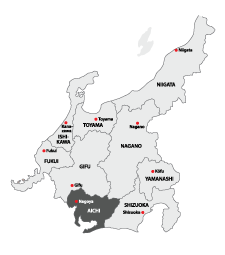 Aichi takes its designation of the land of the samurai very seriously. A number of important battles took place during the warring state or Sengoku period in this strategic area of the country. Aichi has a long history and is associated with some of Japan’s notable historical figures – Oda Nobunaga, Toyotomi Hideyoshi, and Tokogawa Ieyasu – all of whom were key players in the unification of Japan. Where there are struggles, there are defenses, and Inuyama, Okazaki, and Kiyosu Castles and the reconstructed Nagoya, Damine, and Asuke Castles are significant examples of castle architecture.
Aichi takes its designation of the land of the samurai very seriously. A number of important battles took place during the warring state or Sengoku period in this strategic area of the country. Aichi has a long history and is associated with some of Japan’s notable historical figures – Oda Nobunaga, Toyotomi Hideyoshi, and Tokogawa Ieyasu – all of whom were key players in the unification of Japan. Where there are struggles, there are defenses, and Inuyama, Okazaki, and Kiyosu Castles and the reconstructed Nagoya, Damine, and Asuke Castles are significant examples of castle architecture.
The area is also a center of industry and production. Global brands Toyota, Brother, and Noritake are found in the area. Those with an interest in advanced rail technology may be interested in visiting the SCMaglev and Railway Park, with its exhibits on conventional and high-speed trains and the latest in magnetic levitating technology. The Toyota Kaikan Museum provides insights into the history and significance of the Toyota corporation and allows visitors to see one of the production facilities. The Toyota Commemorative Museum of Technology and the classic car collections of the Toyota Automobile Museum provide even the most fervent automobile enthusiasts with a feast of discoveries. The Aichi Museum of Flight in Toyoyama chronicles the development of air transport in Japan.
The area is also associated with traditional crafts. Tokoname is one of the ancient kilns of Japan and is a well-known pottery producing region. Toyohashi, on Mikawa Bay, is known for its annual summer fireworks festival, the Hono no Saiten festival, where brave native sons of the city hold large cylinders akin to cannons that shoot plumes of sparking fireworks upward into the night sky.
Nagoya, the capital of the prefecture, is the third largest city in Japan. It is a transportation center. Nearby Centrair airport is an international gateway into central Japan, while Nagoya airport handles domestic flights. Nagoya lies between Tokyo and Kyoto or Osaka on the shinkansen. It is also the hub for the private regional Meitetsu line. Aichi is located at the heart of the historic Tokaido – the ‘sea road’ traversing the country, versus the internal route of the Nakasendo. Samurai and merchants travelled along the route, which connected Edo (modern-day Tokyo) with Kyoto and Osaka. In days past, travellers followed the route on foot or by horseback. In modern times, the 510 km (320 mile) route has been given over to rail and the bullet trains, though some signs of its rich history remain in Edo period buildings, particularly in towns like Arimatsu or Toyohashi. The Meiji Mura museum brings to life architecture from the time under Emperor Meiji, when Japan began a period of industrialization.
Nagoya itself, as an important industrial center, was a target of US bombing during World War II. Much of the city was razed and a new modern center emerged. Despite this destruction, a number of important historical sites remain. Atsuta Shrine in Nagoya has a history of nearly 2000 years, and is said to be home to one of the three ancient Imperial regalia of Japan – the sword Kusanagi no Tsurugi. (The other two are the mirror, Yata no Kagami held at Ise Shrine, and the jewel, Yasakani no Magatama, held in Tokyo at the Imperial Palace. While none of these regalia are exhibited publicly, the shrine holds a number of other significant swords and relics in its Treasure Hall. A section of a wall built of roof tiles by warlord Oda Nobunaga to protect the shrine also still stands. The city’s Osu Kannon Temple is one of the famed 33 Kannon Temples in old Aichi, known previously as Owari. Stretching outward from the temple are shopping arcades that are an interesting area to while away a few hours. Bansho-ji Temple, associated with Oda Nobunaga, can also be found in this area.



Nagano Prefecture
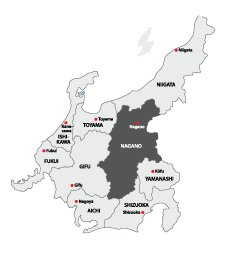 Nagano prefecture is a paradise for those who enjoy year round outdoor pursuits, particularly mountain pursuits, as the area lies squarely in the Japanese Alps. In the winter it is home to great skiing, particularly in the Hakuba area and Shiga Kogen. The city and surrounding mountains hosted the 1998 Winter Olympic games. In the Hakuba area, there are 11 ski resorts offering a variety of options. The many hot springs resorts in the prefecture such as Nozawa Onsen, Shirahone Onsen, Bessho Onsen, Asama Onsen, and Shibu Onsen provide a respite from the winter cold. This respite comes not just for human travelers – the ‘snow monkeys’ of Jigokudani Monkey Park near Yudanaka Onsen are also familiar with the joys of a warming soak in a hot spring. Not far lies Obuse, a town with a quiet historic area worth strolling, and museums associated with woodblock print artist Hokusai, who settled here in later years.
Nagano prefecture is a paradise for those who enjoy year round outdoor pursuits, particularly mountain pursuits, as the area lies squarely in the Japanese Alps. In the winter it is home to great skiing, particularly in the Hakuba area and Shiga Kogen. The city and surrounding mountains hosted the 1998 Winter Olympic games. In the Hakuba area, there are 11 ski resorts offering a variety of options. The many hot springs resorts in the prefecture such as Nozawa Onsen, Shirahone Onsen, Bessho Onsen, Asama Onsen, and Shibu Onsen provide a respite from the winter cold. This respite comes not just for human travelers – the ‘snow monkeys’ of Jigokudani Monkey Park near Yudanaka Onsen are also familiar with the joys of a warming soak in a hot spring. Not far lies Obuse, a town with a quiet historic area worth strolling, and museums associated with woodblock print artist Hokusai, who settled here in later years.
In the green season, the area offers wonderful hiking options. While the historic Nakasendo Trail stretches 534 kilometers between Kyoto and Tokyo, some of the best hiking and prettiest trails can be found in the section of the Nakasendo that meander through the historic and preserved post towns of the Kiso Valley. Of the 11 post towns along the Kiso Valley, some of the most beautiful are Tsumago and Narai, which appear much as they would centuries ago. Kiso-Fukushima lies midway along the trail and is well placed for access to the Kaida Kogen and Mt Ontake, considered to be a sacred mountain in the area. The hiking in the area is accessible and beautiful, winding from village to village along forested trails, passing waterfalls, bamboo groves, rice terraces, and small settlements. The hike here allows for a discovery of Japan’s history and is imbued with the local mountain culture. In this forested area, woodworking is a highly elevated craft in the area, particularly items made with Hinoki cypress. Outside of the Kiso Valley, the Nakasendo post town of Suwa is home to Suwa Taisha, an ancient Shinto shrine dating back 1400 years. The hike can extend along to Karuizawa, which is a popular resort town, a summer getaway from Tokyo, but which also has its own beautiful walking nearby. The Shiraito Falls, near the town, stretch for 70 meters in width, giving the impression of a curtain of water.
For those seeking more challenging hiking, the Kamikochi area is only accessible from late April through to October due to its altitude and snow. More moderate and naturally stunning hiking can be found along the river and ponds of Kamikochi, and in the Norikura highlands, but the area is also the gateway for skilled climbers with mountain certified guides wishing to tackle an ascent of Yarigatake, or seeking to attempt the more advanced Omote Ginza, Yari Hotaka Circuit, or Northern Alps Traverse. Those wishing to enjoy the mountain views without the climb can visit Mount Hotaka or Komagatake by cable car.



Matsumoto is a great place for an overnight stop in the area. Matsumoto castle was restored from a state of near ruin with the support of the city, and its imposing dark colour has given it the nickname of the ‘crow castle’. Matsumoto also has a small district of preserved Kura buildings – merchant buildings built with thick walls to protect their contents from fire – and many of these have now been converted into boutiques and restaurants. The city’s art museum contains works by native daughter Yayoi Kusama. The city also provides transportation links into the mountain by bus, and also to the Utsukushigahara Highlands.
For those that wish to enjoy the mountain specialities of the area, sansai, or mountain vegetables, are a treat – especially in springtime. The clear waters of the area, particularly near Azumino, just outside of Matsumoto, make it well suited for the cultivation of wasabi. One of the largest wasabi farms lies near here. Oyaki, soba, and gohei mochi, simpler mountain foods that sustain local residents, are also delicious here at the source. Oyaki are small baked dumplings filled with local vegetables. Soba noodles, made from the buckwheat that grows at these higher altitudes is a local favorite. Gohei mochi is made from pounded rice, coated with a delicious sweet and savoury sauce made of ground walnuts or sesame, and miso, which are then grilled.
Nagano City, another key transportation hub for the area, is home to Zenkoji Temple. The Temple is a National Treasure and Nagano city is an example of a Monzen-machi, a city that emerged around a key temple or shrine. Zenkoji is the home of one of the oldest Buddhist images in Japan, which is only put on display every six years. While the temple dates back to the 7th century, the current building dates from the 1700’s. Zenkoji Temple is a temple of pilgrimage and visits for the early morning prayer service are popular. It is also possible to stay overnight here in shukubo lodgings. Those visiting later in the day can enjoy the shops and restaurants along the approach, servicing pilgrims’ more earthly desires. For those seeking further spiritual enlightenment, north of the city is Togakushi and its much larger forested complex of three shrines that ascend the mountain stages. In the warring states period, the area was associated with the Togakure Ninja and it is possible to learn about their skills here at various attractions. During the warring states period, a number of samurai battles took place in the area. The Togakushi area is also associated with Japan’s creation myth. Imposing and ancient cryptomeria trees can be found in the shrine grounds, and along the paths between them, emphasizing the smallness of humankind in a much larger world.



Niigata Prefecture
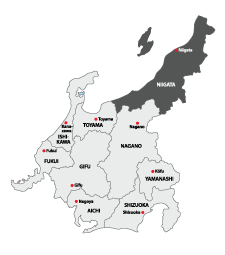 North of Nagano Prefecture, bordered by the Tohoku and Kanto areas and the Sea of Japan is Niigata Prefecture. Niigata prefecture is known for its mountains and hot springs as much as its coastline and Sado Island. The area is popular with skiers and the ski resorts of Echigo-Yuzawa and Myoko are easily reached by bullet train. The 16 ski resorts of Echigo-Yuzawa attract many skiers with the group lift passes that allow skiers access to a combination of ski resorts. When that last run of the day is done, hot springs in the area offer an opportunity to chase away the cold by soaking in an onsen. When the snows recede, the area retains its natural beauty.
North of Nagano Prefecture, bordered by the Tohoku and Kanto areas and the Sea of Japan is Niigata Prefecture. Niigata prefecture is known for its mountains and hot springs as much as its coastline and Sado Island. The area is popular with skiers and the ski resorts of Echigo-Yuzawa and Myoko are easily reached by bullet train. The 16 ski resorts of Echigo-Yuzawa attract many skiers with the group lift passes that allow skiers access to a combination of ski resorts. When that last run of the day is done, hot springs in the area offer an opportunity to chase away the cold by soaking in an onsen. When the snows recede, the area retains its natural beauty.
Niigata is not just popular with skiers. In July, music fans descend on the Naeba ski resort for the Fuji Rock Festival. Every three years, the area hosts the Echigo-Tsumari Trienneale. More lasting installations are available every year in the Echigo Tsumari Art Field
Sado Island was once an island of exiles and outcasts off the coast from Niigata. Those that were sent here in punishment for their radical ideas or for falling out of favor with the powers that be brought with them their love of culture, of art, and of their beliefs – building a lasting cultural heritage on the island that includes numerous ancient and historic temples, many featuring No drama stages. Sado Island is also home to the famous Kodo drummers – a taiko troupe that has received fame and acclaim touring overseas. They are a highlight of the broader Earth Festival held during the summer on the island. Tarai bune, or washtub shaped boats are a feature of the island and while they are not commonly used today, you can venture out from the preserved Shukunegi district on a boat and feel like you’ve jumped into the ‘Spirited Away’ anime. Unique wildlife can be found on the island, – the toki or crested ibis have a sanctuary on the island. Sea kayaking is possible in the clear waters of Ogi port on the south side of the island. The island still bears the physical scar of the gold and silver mines on the island with a mountain peak cleaved in two by mining these precious resources. The dramatic coastline of the island, particularly in the Futatugame area, is breathtaking.
Kiyotsu Gorge is one of Japan’s stand out gorges. It can be viewed rather uniquely from the Panorama Station of the Kiyotsu Gorge Tunnel for a breathtaking and reflective view of the gorge below. Beautiful cherry blossoms can be enjoyed near Mt. Kasuga in the Joetsu area in Takada Park. Nearby, you’ll find the ruins of the castle that was once home to the powerful regional lord, Uesugi Kenshin.
Niigata is a rice producing region, and for beautiful examples of traditional rice terraces, the stepped Hoshitoge rice terraces in the Tokamachi area and the Yamakoshi rice terraces in the Nagaoka area look little changed over the centuries as they cling to the hillside. Where there is rice, and fresh mountain-fed streams, there is sake. The entirety of Niigata is known for its sake production and breweries can be found in the mountains as well as areas nearer the sea. In Niigata, Nagaoka, and Echigo-Yuzawara stations you’ll find branches of Ponshukan, where vending machines dispense over 100 different types of sake, allowing you to become your own sake sommelier while waiting for your train. In Nagaoka, the Settaya district is home to a number of brewers of sake, soy sauce, miso, and sake.
Niigata city is a transportation hub for the area and is accessible by rail, air, or sea and is a departure point for ferries to Sado Island. As the preeminent city of the prefecture, it’s a wonderful place to dine on the fruits of the surrounding areas. The sake of the area pairs well with some of the freshest fish and seafood in the area. If you would rather view sea life, the aquarium in Niigata is well regarded for the breadth of its collection. The Nuttari Terrace Street has a retro feel and new shops are breathing new life into an area that was largely populated by empty storefronts. Niigata city’s sake fair in March is also a highlight for sake lovers.



Gifu Prefecture
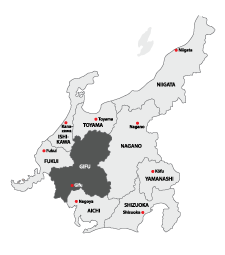 Gifu prefecture lies to the West of Nagano Prefecture and shares some of its mountainous terrain. It is probably best known for Takayama, once an important regional outpost in the mountains, with Takayama Jinya, the only remaining regional government outpost of the Edo era, at its hub. The town remains an important population center in the area, but the old town area retains a traditional feel. The Sanmachisuji area contains a number of preserved buildings that now house boutiques, restaurants, and sake shops – keeping them true to their merchant origins. For those who would like to explore this architecture in greater depth, some remain in close to their original form as museums. The lively morning markets at Takayama Jinya and along the riverside are visited by locals and tourists alike. The Higashiyama temple district once skirted the castle, but has outlived it through the devotion of locals. Takayama is probably best known for its spring and autumn festivals, during which animated festival floats are paraded through the town – much to the delight of visitors and locals.
Gifu prefecture lies to the West of Nagano Prefecture and shares some of its mountainous terrain. It is probably best known for Takayama, once an important regional outpost in the mountains, with Takayama Jinya, the only remaining regional government outpost of the Edo era, at its hub. The town remains an important population center in the area, but the old town area retains a traditional feel. The Sanmachisuji area contains a number of preserved buildings that now house boutiques, restaurants, and sake shops – keeping them true to their merchant origins. For those who would like to explore this architecture in greater depth, some remain in close to their original form as museums. The lively morning markets at Takayama Jinya and along the riverside are visited by locals and tourists alike. The Higashiyama temple district once skirted the castle, but has outlived it through the devotion of locals. Takayama is probably best known for its spring and autumn festivals, during which animated festival floats are paraded through the town – much to the delight of visitors and locals.
Just a short distance away is the town of Hida Furukawa – a pretty town that has much of the same traditional feel, due to its preserved buildings of merchants and artists, but being somewhat removed from the main hub of Takayama, is a bit more tranquil. The Oku Hida hot springs areas of Shin Hotaka Onsen, Tochio Onsen, Fukuji Onsen, Hirayu Onsen and Shin Hirayu Onsen collectively have the most outdoor baths in Japan, many with mountain views.
The Shirakawago area nearby is a UNESCO World Heritage Site, and the village of Ogimachi is known for its Gasshozukuri farmhouses, made with steeply pitched thatched roofs that protect their inhabitants from the heavy winter snows. They are often called ‘praying hands’ houses which is the root of the name of these farmhouses as the steep pitch of the roof resembles hands joined in prayer. It’s possible to stay in one of the gasshozukuri as some are now operated as small family run inns. The community spirit learned long ago in seeking to survive the long cold winters remains and when one of the houses in the community needs to be re-roofed, the entire community will turn out to assist.
In the more southern areas of Gifu prefecture, the hot springs resort of Gero Onsen has a long history and its waters have been renowned for their healing properties since the Tenryaku era in the 900’s. It has long been considered one of Japan’s three great hot springs. Gujo Hachiman, lying to the west of GIfu City, is famous for its all night bon-odori dances during the festival of O-bon, when ancestors are welcomed back from the spiritual plane with entertainment. Even outside of this August festival, the town is lined with canals and sits along the river. Gujo is also known for its production of food models – a great if quirky souvenir would be a hand-made food replica, just like those appearing in the windows of restaurants in Japan.
Gifu is also an area of living traditions. At Mino, you can learn about the famous washi paper making or pottery traditions of the area. While Mino has an attractive old district of merchant buildings with udatsu or protective thick walls, washi paper making is not trapped in history and there are many artists engaging in innovative paper crafts. Seki has been a center for the intricate and highly skilled smithing that produced famous swords for 700 years, and still engages in metalworking today -though knives are now in greater demand than swords. In the summer months, it is possible to watch cormorant fishing along the Nagara river. Gifu castle stands over the city and was once home to Oda Nobunaga, one of Japan’s great warlords during the warring states period.
Gifu played an important role in the unification of Japan. The Battle of Sekigahara was the great clash of Western and Eastern forces, and was decisive in the success in this unification by Tokugawa Ieyasu and the exercise of control over Japan by the Tokugawa Shogunate in the Edo period. The Nakasendo was one of the ancient kyukaido or routes traversing the Japanese main island of Honshu. In Japan’s feudal period, it was the road through the mountains taken by merchants, but following the establishment of Tokugawa rule, the route became one of the key means for crossing the country. The policy of ‘sankin-kotai’ required the subdued daimyo or lords to travel periodically between the new capital of Edo (now Tokyo) and their domains. The Nakaendo was heavily travelled in the Edo period and a section of these 69 post towns lies in Gifu prefecture. While some of these still offer hiking, such as Ena, Nakatsugawa and Magome, other parts of the route have been given over to roads, best accessed by bicycle.



Toyama Prefecture
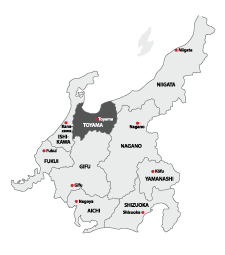 Toyama likes north of Nagano and Gifu prefectures and east of Ishikawa Prefecture on the Sea of Japan. In its mountainous south, just as with Gifu prefecture, Gasshozukuri houses stand proud in Gokayama – the villages of Ainokura and Suganuma. These villages are lesser known but are no less picturesque than those of Ogimachi and are also . The area is one of but a few in Japan that produce doburoku sake, a less filtered more milky looking sake that is worth the journey for sake aficionados.
Toyama likes north of Nagano and Gifu prefectures and east of Ishikawa Prefecture on the Sea of Japan. In its mountainous south, just as with Gifu prefecture, Gasshozukuri houses stand proud in Gokayama – the villages of Ainokura and Suganuma. These villages are lesser known but are no less picturesque than those of Ogimachi and are also . The area is one of but a few in Japan that produce doburoku sake, a less filtered more milky looking sake that is worth the journey for sake aficionados.
Those that wish to enjoy the snow even late into the summer may want to visit the Tateyama Kurobe Alpine Route, known for its roads surrounded by high walls of snow late into the summer. The route is not passable from December through to mid April due to the heavy snows, and the road corridors are formed by special equipment designed to make the roads passable from late spring. In summer weather, the route can be travelled by a variety of modes of transport – train,cable car, bus, trolley car, ropeway, and cable car. Murodo, along the route, is a gateway to hiking in the Tateyama area and the Kurobe dam is a feat of engineering in the punishing conditions of the area. Separated from the Tateyama Kurobe Alpine route by Mount Tateyama is the Kurobe Gorge – one of the steepest gorges in Japan. This is accessed by an entirely different route from the Tateyama Kurobe Alpine route, and the Kurobe Gorge Railway is much beloved by train enthusiasts. The area is especially popular in the autumn months during foliage season when visitors enjoy the views and hot springs in the area.
Takaoka is a smaller historic city in the prefecture founded by the powerful Maeda clan. It is known for Zuiryuji temple, an exemplary zen temple, as well as the Takaoka Daibutsu – one of Japan’s three great large Buddha statues. The town also has a preserved townscape in the Kanayamachi and Yaachosuji districts that were once home to craftspeople and merchants. The area is known for its metalworking and foundries. Toyama city, the administrative and transport hub of the prefecture, is a modern city with museums that illustrate the cultural and crafting traditions of the area. The Toyama Glass Art Museum impresses not just with its contents, but with its building designed by Kengo Kuma. Toyama is also known for traditional Japanese medicine, and preserved pharmacies keep these traditions alive. Toyama was a castle town, and a replica of the original castle buildings stand on the former castle grounds. Trout sushi is a delicious specialty of the area.



Ishikawa Prefecture
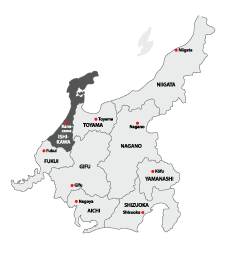 Ishikawa prefecture sits to the west of Toyama prefecture, also on the sea of Japan. Nearly half of the prefecture stretches like an arm into the Sea of Japan with the Noto peninsula, or Noto Hanto. The further north one travels, the more rural the area becomes, with long sandy beaches, imposing cliffs, fishing villages and smaller seaports. The western side of Noto Hanto is where you’ll find Chirihama beach, a sand beach sufficiently packed to cycle or drive on. This long smooth beach contrasts with the coastline further north, with dramatic cliffs above the sea at Noto Kongo. Sojiji Temple was once the primary temple of the Soto Zen sect and remains important to followers today, as evidenced by donations to fund repairs to buildings that had been damaged by an earthquake.
Ishikawa prefecture sits to the west of Toyama prefecture, also on the sea of Japan. Nearly half of the prefecture stretches like an arm into the Sea of Japan with the Noto peninsula, or Noto Hanto. The further north one travels, the more rural the area becomes, with long sandy beaches, imposing cliffs, fishing villages and smaller seaports. The western side of Noto Hanto is where you’ll find Chirihama beach, a sand beach sufficiently packed to cycle or drive on. This long smooth beach contrasts with the coastline further north, with dramatic cliffs above the sea at Noto Kongo. Sojiji Temple was once the primary temple of the Soto Zen sect and remains important to followers today, as evidenced by donations to fund repairs to buildings that had been damaged by an earthquake.
In Oku Noto, on the northernmost edge of the peninsula lies the local hub of Wajima. Waima is known for its morning market, which over its 1000 year history was run primarily by the women of the peninsula as their husbands took to the sea to fish. Today it features not just seafood, but local delicacies and souvenirs. The area is also known for its production of lacquerware and there are shops and a museum which illustrate the many ways this craft has been applied. Wajima is also known for the Kiriko museum, dedicated to the illuminated lantern floats created for a local festival. Further east along the Oku Noto coast, you’ll find Shiroyone Senmaida rice terraces that step down the hillside to the sea at its base.The Tokikuni houses once were home to residents of the Taira clan, who retreated here following the Genpei war. It is possible to visit these traditional thatched roof homes. Continue on and you’ll find treasures such as traditional sea salt makers, fishing villages, unique rock formations, and houses hidden behind walls of bamboo to protect them from the punishing winds. Heading south along the eastern side of the peninsula brings you to Wakura Onsen, a hot springs resort of large onsen ryokan.



Kanazawa sits at the Western base of the Noto peninsula and is the primary city of Ishikawa prefecture. Access to the city was improved with the extension of the Hakutaka bullet train from Tokyo to Kanazawa. The area was once the domain of the powerful Maeda clan and was the center of the Kaga domain. The Maeda clan were active patrons of the arts. As a result, the area is a gem for those looking for a taste of traditional Japan in a compact city setting. The Maeda clan prospered during the period of peace that reigned in the Edo period, and rather than being occupied by battle, could indulge their love of craftsmanship and art leaving its mark on the city today. Kanazawa is known in particular for its production of gold leaf, and is still where 99% of Japan’s gold leaf is produced today. The prefecture’s skill in lacquerware often sees these two crafts married together in maki-e lacquerware. Kaga dyed silk is prized by makers and wearers of kimono for its beautiful colours and artful designs. Kutaniyaki or pottery is also a well known craft throughout Ishikawa prefecture.
Indeed, it is easy to lose oneself in the many traditional townscapes remaining. Kanazawa, like Kyoto, escaped extensive bombing in World War II and many vestiges of the past remain. The city has three preserved geisha districts, some of which still have active communities of Geisha today. The Higashichaya, Nishichaya, and Kazuemachi districts still retain their traditional wood lattice fronted tea houses that hark back to the Edo period. At the heart of the city is the Kanazawa Castle Park. The primary keep of the castle no longer remains, but stylish gates and the Oyama shrine are intriguing in style. The city may arguably be best known for the Kenrokuen gardens, considered to be one of the finest examples of a strolling garden in Japan. For an interesting study of the adoption of Western architecture to Japanese style and living, the Saisonkaku villa within its grounds is well worth visiting. The Nagamachi samurai district also harks back to the past, with its clay walls and small canals. It’s possible to visit the Nomura samurai house for a taste of life at home for a samurai. Interesting for its many safety and security measures, Myoryuji Temple, known as the ‘ninja temple’ is replete with trap doors, secret observation holes, and hidden spaces. The temple served in part as a building of faith, but also had a role in the defence of the Maeda clan, when regional lords were not permitted to have noticeable defenses of their own. The temple sits in the Teramachi district of western Kanazawa where many temples devoted 100% to serving the spiritual needs of the city are still found today.
With such a strong presence of art and craftsmanship in the city, it is no surprise that there are museums of many descriptions in the city to display these works of art. There are a number of museums with broader collections of traditional crafts, such as the Prefectural Museum of Art, the Craft Museum, and the Honda Museum,, there are also museums focused on local products, such as gold leaf crafts or Kaga Yuzen dyeing. Modern art is also beloved and exhibited in the city at the 21st Century Museum and the DT Suzuki Museum. For those that enjoy artfully prepared seafood, Omicho market, near Kanazawa station, is well worth a wander. The market features not just seafood but many other foods that proudly stock local kitchens and restaurants.
South and west of Kanazawa are Hakusan and the Kaga onsen area. Mt Haku is one of the three famous sacred mountains of Japan and is one of the highest peaks of Western Japan. It straddles Gifu and Ishikawa prefecture and is the center of the Hakusan faith. This dormant volcano lies at the centre of the Hakusan National Park. It is possible to hike and there are a number of trails but access to the area is somewhat challenging, and the hiking season, due to the altitude and heavy snow, is only possible between June and October and is accessed from Bettodeai. Natadera temple is a Shingon Buddhist temple that was founded in 717 by the monk Taicho who travelled here in search of the area’s legendary pure white goddess, and found instead a kannon Buddha. The caves in the area of Natadera were revered as sacred as early as the Jomon era. The upper shrine of Shirayamahime Shrine lies at the top of the mountain, but at lower levels in Hakusan town, the larger shrine can be found. This Shinto shrine has a 2100 year history and is also dedicated to the spirits of Mt. Haku, and a focal point for those who ascend the mountain as a part of their devotion to the Hakusan faith.
Kaga Onsen is home to 4 main onsen areas – Katayamazu Onsen, Yamashiro Onsen, Yudanaka Onsen, and Awazu Onsen. Each of these hot springs resort towns offers delightful bathing in natural mineral hot springs and both traditional and modern ryokan. The onsen resorts also have public baths, and footbaths placed throughout the town. Of course the many ryokan that serve those seeking to enjoy the onsen have their own onsen in house, some of which can be visited for a fee for day bathing by those not staying over. The hot springs were discovered 1300 years ago, so the area has a long history of welcoming those wishing to take to the waters to heal or restore themselves in other ways. Awazu onsen is home to Hoshi Ryokan, one of the oldest hotels in the world and has been in operation since the year 718. Katayamaza Onsen is well known for its many lakeside baths, and with its proximity to the sea, is known for crab in the winter months. Yamashiro Onsen has a more modern style renovated public bath and is well known for its Kutaniyaki pottery. Yamanaka onsen lies deeper in the mountains, near the beautiful Kakusenkei gorge. The well travelled poet Matsuo Basho considered Yamanaka Onsen to be one of the three best onsen in Japan- ranking up there with Kusatsu Onsen and Arima Onsen. Today its quaint townscapes with small boutiques make it a lovely location to while away a day following some time in the baths.



Fukui Prefecture
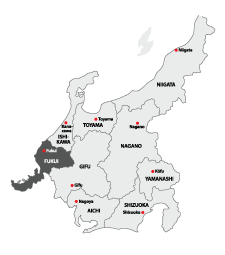 Fukui Prefecture lies to the West of Ishikawa Prefecture on the Sea of Japan. To the Southeast likes Gifu Prefecture and to the South and West, Shiga and Kyoto Prefectures. Fukui was once the domain of the powerful Matsudaira Clan, as well as the Asakura clan, who were based at Ichijodani. The Matsudaira Clan remained powerful throughout the Edo and Meiji period. The fortunes of the Asakura clan were not so favorable.The family ruled the area for 103 years during Japan’s fractious Warring States period until the clan was defeated by Oda Nobunaga. The ruins of their home castle town, at its peak during the Momoyama era, can still be visited on the outskirts of Fukui City in Ichijodani today. Nobunaga burnt the town to the ground, but following excavation of the site in the 60’s some restorations were made to give an impression of the castle town.
Fukui Prefecture lies to the West of Ishikawa Prefecture on the Sea of Japan. To the Southeast likes Gifu Prefecture and to the South and West, Shiga and Kyoto Prefectures. Fukui was once the domain of the powerful Matsudaira Clan, as well as the Asakura clan, who were based at Ichijodani. The Matsudaira Clan remained powerful throughout the Edo and Meiji period. The fortunes of the Asakura clan were not so favorable.The family ruled the area for 103 years during Japan’s fractious Warring States period until the clan was defeated by Oda Nobunaga. The ruins of their home castle town, at its peak during the Momoyama era, can still be visited on the outskirts of Fukui City in Ichijodani today. Nobunaga burnt the town to the ground, but following excavation of the site in the 60’s some restorations were made to give an impression of the castle town.
Despite the history of Fukui, it remains one of Japan’s least populated prefectures. Many of the signs of this history have been lost to earthquakes or to war, but some vestiges of the prefecture’s past remain. One can still stroll through the Yokokan gardens, once gardens of the Matsudaira clan. Maruoka Castle is one of just 12 original castles remaining in Japan. Little remains today but its original keep. The former castle grounds are a popular park for locals during cherry blossom season. The restored Echizen Ono castle is often called the ‘castle in the clouds. It sits perched on the top of a mountain and when the weather conditions are correct, it appears to float in the sky above the low lying clouds that fill the valleys below.
Fukui is best known as the home of Eiheiji – a zen temple and monastery complex nestled in the woods outside of Fukui City. It is one of the two main hubs of Soto zen in Japan, a branch of Zen Buddhism that was brought to Japan from China in the 1300s. Today, the temple’s monastery is home to approximately 200 monks and nuns in training, following a strict regime of devotion.
The mark of time stretches back hundreds of thousands of years. The area is home to some of the best preserved dinosaur remains in Japan and a number of dinosaur skeletons, bones and fossils can be found at the Fukui Prefectural Dinosaur Museum in Katsuyama, near to the Kitadani Dinosaur Quarry to the east of Fukui city.
The Echizen coast offer spectacular beauty – stretching from the spectacular coast at cliffs at Tojinbo, forged many million years ago, to the port town of Tsuruga.The basalt cliffs at Tojinbo stretch for a kilometer along the coast, with the stone pillars characterised by their hexagonal shape. A local legend says that a corrupt local priest was so disliked that he was killed after being thrown off the cliffs by the community. Echizen is well regarded by food lovers or Echizen crab, harvested in the winter months along the coastline. One of Echizen’s best known crafts is traditional washi paper, made from mulberry, mitsumata, or gampi bark. The skill for making washi paper is said to have been passed by a Goddess to the local people so they could make a living despite having unsuitable land for cultivating rice. The pretty Okamoto-Otaki shrine enshrines this Goddess of paper. A washi village in Echizen offers a gathering point for artisans. Echizen yaki or pottery, is an unglazed form that has a simple style that is fired at a high temperature, creating unique designs. Echizen is also famous for its production of knives from the 1300s The Echizen Uchihamono Kaikan shows the laborious process of making knives the traditional way – a reason why they are prized by chefs not just in Japan but from all over the world.
For centuries, Tsuruga has been a port town. Those who work the sea for a living understand its power and danger, and are often devout praying for divine intervention to protect and keep them safe. In Tsuruga, Kehi shrine was where many prayers were offered. For those not seeking intercession, a number of beautiful beaches can be found outside of Tsuruga along the coast. Kelp is also a product of the area and the old brick warehouse that were the focus of this kelp processing
Heading further west and south along the coast leads to Wakasa Bay – known for its clear waters. The Ramsar protected Mikata five lakes area can be discovered by boat. Locally, Wakasa lacquerware incorporates the gifts of the sea in its style – using not just the highly polished lacquer in design, but also eggshells and seashells to decorate woodworks.



